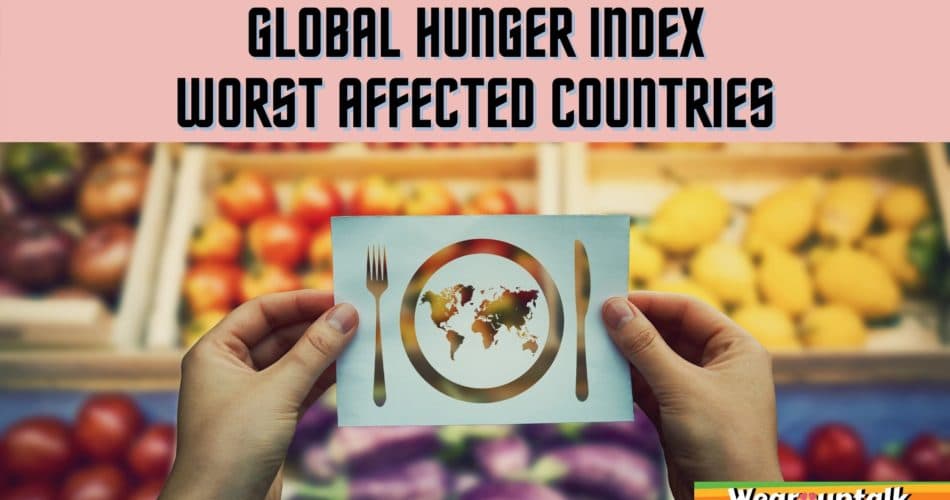How a hungry or a starved person is not an ideal example of a citizen with fundamental rights? How would peace be a magnanimous problem if hunger still prevails in the world? Stating it as a valid point, Jimmy Carter beautifully said, “We know that a peaceful world cannot long exist, one-third rich and two-thirds hungry.”
Now, the question arises that how do we measure hunger on a global level? Is it even possible to quantify a feeling- a feeling of starvation or thirst? If it is possible to assess world hunger, then how can we do so?
Well, the Global Hunger Index is an annual report jointly published by Welthungerhilfe and Concern Worldwide designed to comprehensively track and measure hunger at the global, regional, and country levels.
What is the Global Hunger Index?
The GHI, which is an acronym of Global Hunger Index indicates that the level of hunger and undernutrition globally declines on the cusp of the moderate and serious categories. Global hunger is calculated by assigning a numerical score based on various aspects of hunger. GHI, comparing current scores with past results comes to new ranks.
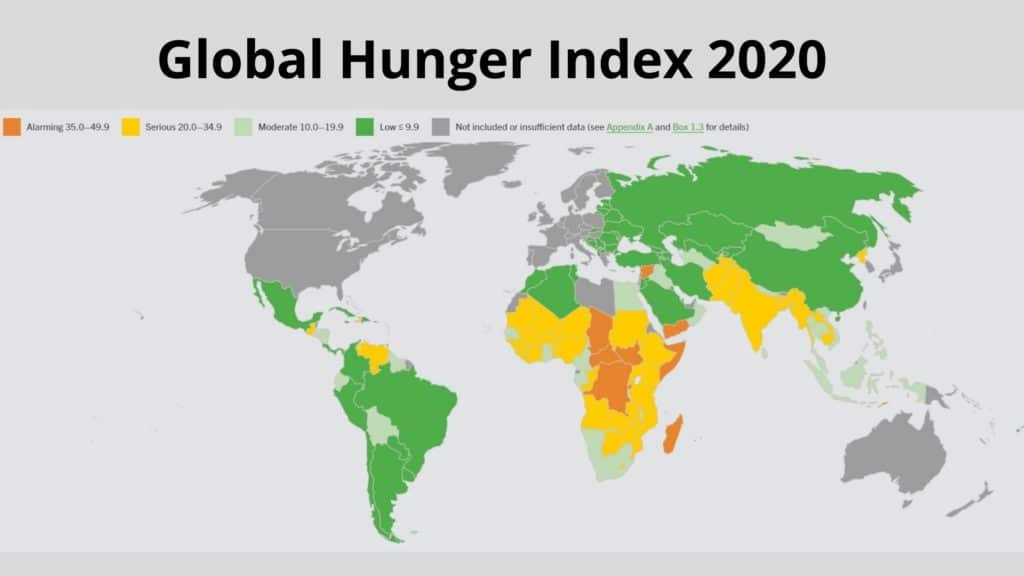
The Index ranks countries on a 100-point scale, with 0 being the best score ironically, which directly means no hunger and 100 being the worst, although neither of these extremes would be observed practice. It can be called more of a percentile system than a direct and detailed survey.
The severity of hunger which has become more of global starvation associated with the range of possible GHI scores is as follows:
- Low ≤ 9.9
- Moderate 10.0-19.9
- Serious 20.0-34.9
- Alarming 35.0-49.9
- Extremely alarming ≥ 50.0
The Global Hunger Index is calculated by observing these few points:
- the ratio of the undernourished as a percentage of the population
- the proportion of children under the age of five suffering from wasting, a sign of acute undernutrition
- the number of children under the age of five suffering from stunting, a symbol of chronic undernutrition
- the mortality rate of children under the age of five years
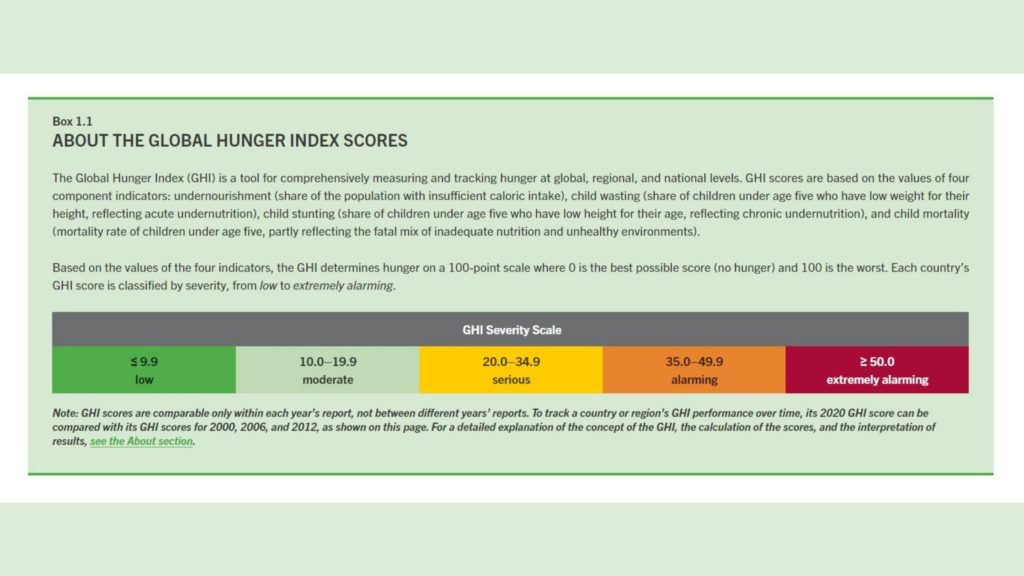
Now, most of you would be wondering about the resources in the world to be sufficient or not resolve such a global crisis. To this common question of every reader, I would want to quote Ed Asner, “There are genuinely sufficient resources in the world to ensure that no one, nowhere, at no time, should go hungry.”
Worst Affected Countries
For now, i.e. October 2020, the Worst Affected Countries would be judged by the GHI 2019. Though the report for 2020 could be expected shortly as this year-2020 is synonymous to uncertainty- so reports of this year.
2019’s report showed that some countries needed immediate attention and help resources.
Hunger hits four countries in the world the hardest, and they are in an alarming stature. The worst-hit countries are Chad, Madagascar, Yemen, and Zambia. The Central African Republic is the only country where hunger index has been the lowest for the consecutive second year. India stood at the rank of 102 in 2019 and 94 in 2020.
Though we are discussing the severity of the situation worldwide related to hunger and starving people, it might be the biggest irony of humankind which was revealed through Salt Inducible Kinases (SIK) study by Food and Agriculture Organisation (FAO) of United Nations in 2011. The study showed that the total of global food loss and waste to around one-third of the edible food produced for human consumption, amounting to about 1.3 billion tonnes per year.
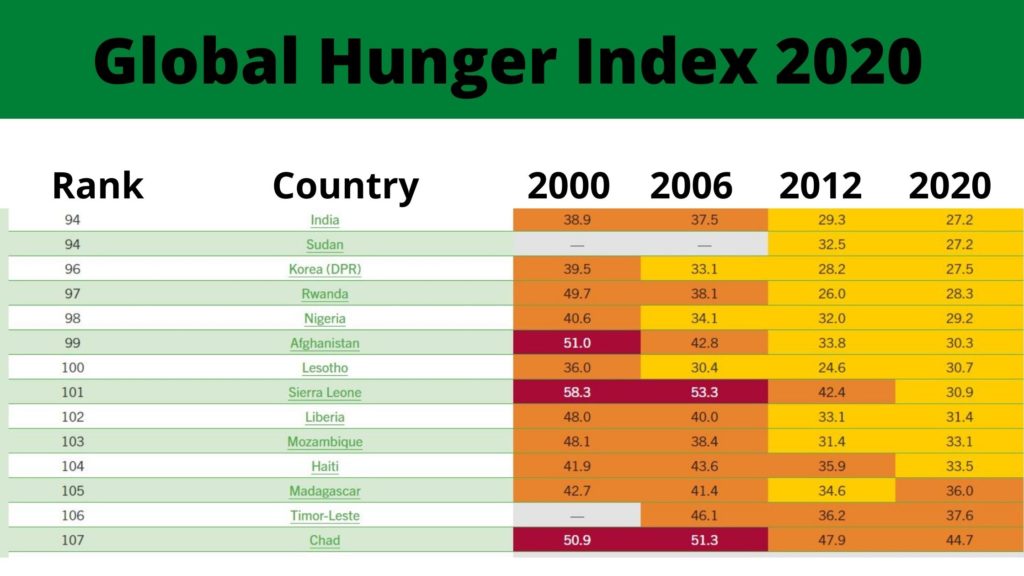
To comment on this paradox, I have a straight yet effective line to share- “Take all that you can eat and eat all that you take”.
The Situation of Hunger in India
As we mention INDIA –There is no way that we forget to mention the father of our nation – MAHATMA GANDHI or popularly known as BAPU. Here is a famous anecdote of his “There are people in the world so hungry, that God cannot appear to them except in the form of bread.”
According to the Food and Agriculture Organisation (FAO), estimates in ‘The State of Food Security and Nutrition in the World, 2020 report, 189.2 million people are malnourished in India. Also, 51.4% of women in their reproductive ages between 15 to 49 years are anaemic. As per this piece of information, 14% of the total country’s population is malnourished.
Based on three leading indicators that are the prevalence of wasting and stunting in children under five years, under-five child mortality rate, and the proportion of undernourished in the population, the global hunger index of 2019 ranked India at 102 and 94 in 2020 out of 117 countries.
However, the country’s government is putting in sustained efforts to reduce this problem of starvation. It has started programmes like the midday meal programme in schools which are slowly bearing its fruit.
This program of midday meal offers free lunches on working days so that the children going to government primary and upper primary classes, government aided, local body, education guarantee scheme and alternate innovative education centres, Madrasas and Maqtabs that are supported under Sarva Shiksha Abhiyan and National Child Labour Project schools run by the Ministry of labour.
It serves 120, 000, 000 children and is the largest of it’s kind in the whole world. This scheme has not only provided children with nutrition but also because of this, more children have enrolled themselves in school and even now getting educated.
Strategies to be Followed
Let me first introduce you to a probably new piece of information for you. The word strategy was derived from the Greek word ‘stratçgos’. If we divide the word into two that is stratus and ago then stratus means the army and ago means leading something or moving.
However big a problem or a crisis may be, there is nothing in this world which wouldn’t have a solution. Every problem can be solved with proper strategy, planning and execution.
Effective implementation of strategies is supposed to be a critical component of the success of an organization and should be a potential source of competitive advantage. It requires a lot of case study, research, recommendations and empirical work that provides us with an insight into the issue and produces a proper framework. It gives a sense of direction to every person connected to it. The more detailed it is, the more better it is.
Here are some general strategies which can be followed:
1. Country Strategic Planning
Every country has its own set of bureaucrats and experts which work on a given issue or feel in the society and for the betterment of the people of their nation. It is these people do the research work, case study, give recommendations and provide with the empirical work to the government so that the government can frame laws on it and work towards it. As you all know, every country has its domain to work on. Every state has its issues concerning geography, population, the functioning of government etc. even though the problem might be the same.
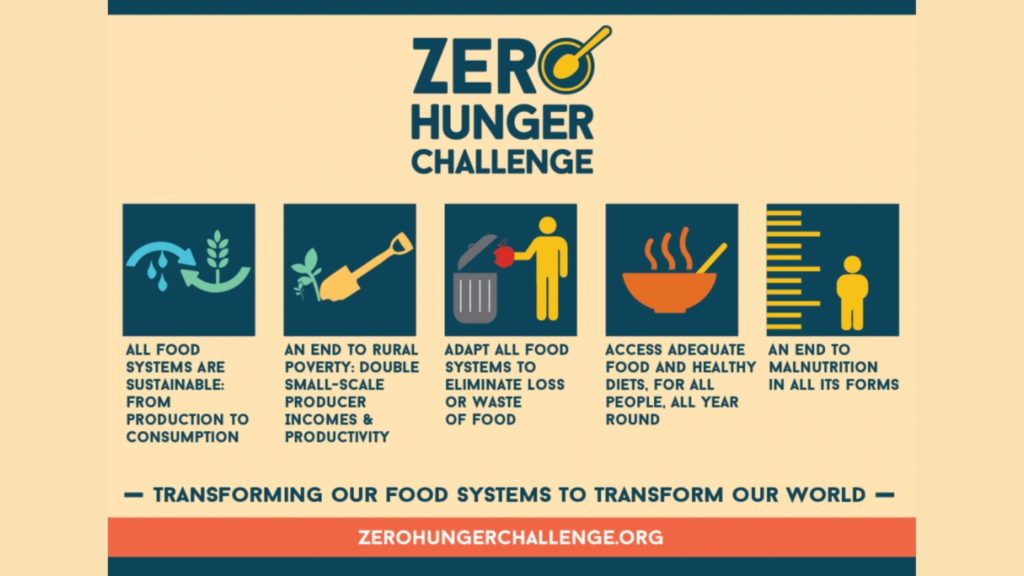
2. Analysis and Assessments
Analysis and assessments are the next steps after strategic planning. It forms a fundamental part of every strategy. It is so very important to do this step because it helps in discovering the identity of the problem and assess which are needed to solve a problem. If there is an opportunity anywhere near it, then it also helps us in taking advantage of it. Analysis of the situation on the ground is the prime step to plan about the smooth functioning of the strategy. Then, assessing the process for practical implications considering both boons and banes id essential.
3. Programme Design
Though the program might be the same for an event, designing it according to the practical needs of the situation is essential. It helps in making the objectives of the program clear for everyone. It also tells what goals need to be achieved by the end of that program design.
The program design is basically creating a blueprint for the development of instructions and how the people attached to it are supposed to go by it. It takes a lot of factors into consideration like viewpoint, elements required for that program, concerns of the people for which the program is being designed and how it will benefit them. This step hence creates a flow of the whole strategy.
4. Types of support
While doing any activity, there are a lot of hurdles that come in the way, to overcome these hurdles, there are various kinds of support that are needed. There are various types of support which would be needed while being on the process of eradication of global or regional hunger. The supports include- Economic Support, Muscle Power, Government support, Moral support and support by the people of the region.
You must have heard the saying, “Every drop in the ocean counts”. So let us do our part and support by whichever way we can for the cause. After all, it is our very own world, and we should show humanity towards other living beings as well. So, we must give whichever support we can.
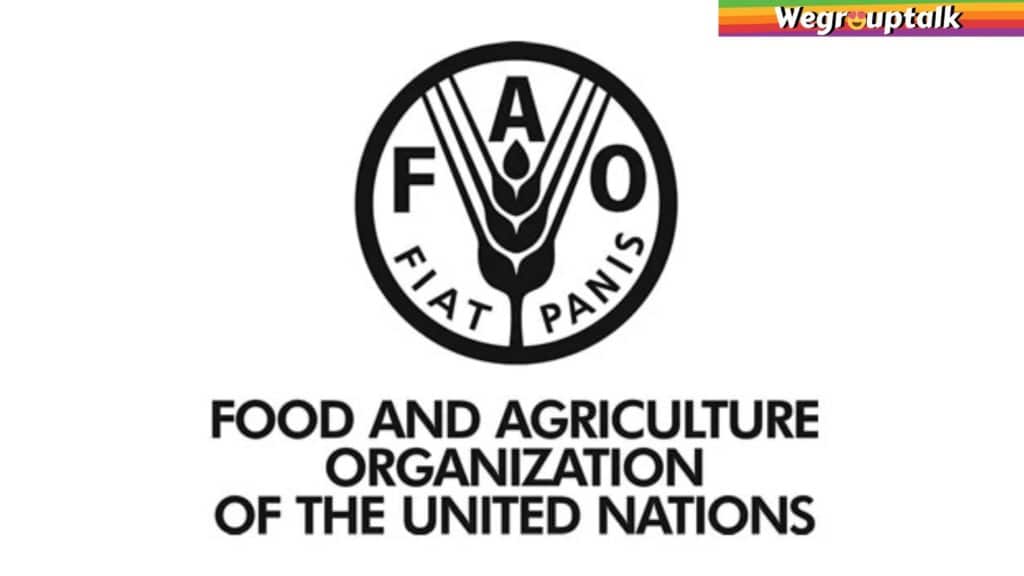
5. Feasibility of Supply
Product Supply should be kept in mind while choosing the location of the production of products. For Example: At a stuck famine area, one cannot afford to provide A1 quality food from a faraway place but the decent quality of food from nearby. Hence for the supply of food to be more feasible, one should engage more in nutrition projects that are around that area itself.
Although, giving food door to door still feels like a difficult task to do in times of famine or other devastating incidents or natural calamities but at least supplying food from the nearby areas makes it feasible for both the giver and the taker of food to reach the people it is supposed to.
6. Monitoring, Evaluation and Learning
When a plan is laid, and the work is being done, it is important to monitor the process for the smooth functioning of the strategy. It should be timely evaluated. The cons or the shortfalls of the strategy should be learnt for future understanding. By monitoring and doing proper surveillance, it helps us in assuring that the thing is being done satisfactorily and whether it is in safe hands or not.
Learning is a continuous process, and it must not be stopped. I am not only talking this concerning the people concerned to the organisations who provide food and help in eradicating hunger but also for us people in general. It helps in gaining experience, which I think is a precious thing.
“Hunger is not a problem. It is an obscenity. How wonderful it is that nobody need wait a single moment before starting to improve the world”.
~Anne Frank
Conditions of Worst Affected Countries
In the world right now, there are over eight 70 million hungry people. I am not even talking about being able to use a hungry snack before lunch or the people who do not get time to eat breakfast but about the people who genuinely and continuously stay hungry sometimes for days altogether. So, let us have a look at the statistics of the Global Hunger Index of the year 2020 and see which all countries have been badly hit by hunger.
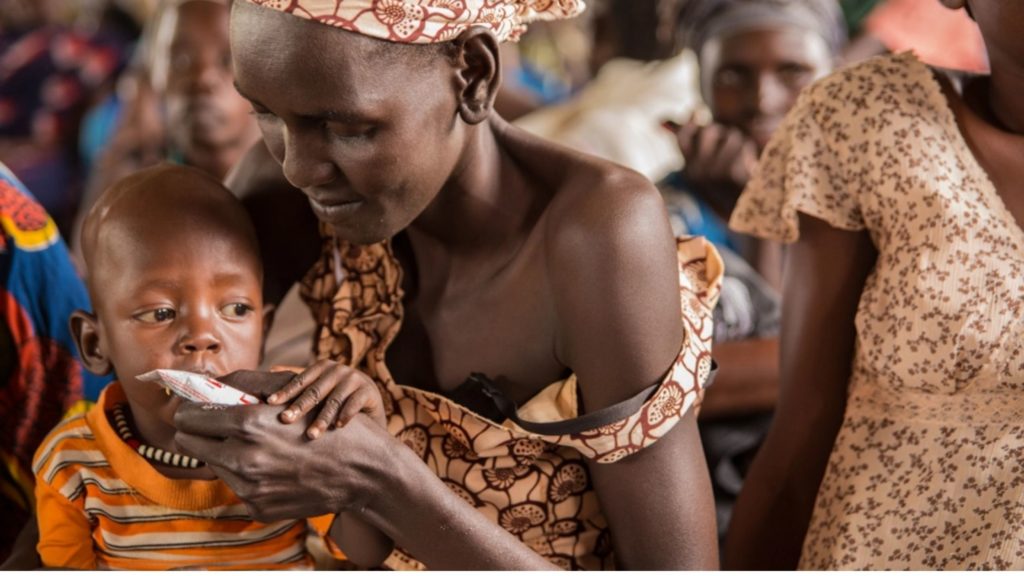
The conditions and strategies to procure four worst hunger struck countries are–
1. CHAD
In the Global Hunger Index, Chad ranks 73rd out of 78 countries. In 2015, more than 2.4 million rural Chadians became food insecure, of which 428,000 people are classified as severely food insecure. Chad was the most affected country by hunger and malnutrition, with an index of 44.7, according to the global hunger index of 2020, adopted by the International Food Policy Research Institute. This country is officially known as the Republic of Chad and is a country in northern Central Africa. It is a landlocked country. The country is still troubled by political violence and re-occurring cow attempts. Chad is one of the world’s poorest and most corrupt countries, most of the inhabitants in the country live as subsistence herders and farmers in poverty.
2. MADAGASCAR
Madagascar’s financial standings are generally from a growing agricultural sector, ecological research and ecotourism. Nearly 80 per cent of the country’s population living below the poverty line due to the unequal distribution of wealth which has left Country-wide poverty, combined with weak government policies, poor functioning of government and a tenuous political situation, has led to an alarming humanitarian crisis. More than half of all children in Madagascar suffer from chronic malnutrition, and over half of the country’s population struggles with food insecurity.
3. YEMEN
The Hunger in Yemen is unparalleled and is causing severe hardship for millions of people. Despite ongoing humanitarian aid, over 20 million Yemenis are food insecure, of which nearly 10 million are acutely food insecure. The proportion of child malnutrition is one of the highest in the world, and the nutrition bar continues to level down. A survey showed that almost one-third of families have gaps in their diets, and hardly ever consume foods like vegetables, pulses, fruit, meat or dairy products. With more than a million women and 2 million children requiring treatment for acute malnutrition, malnutrition rates among children and women in Yemen remain among the highest in the world.
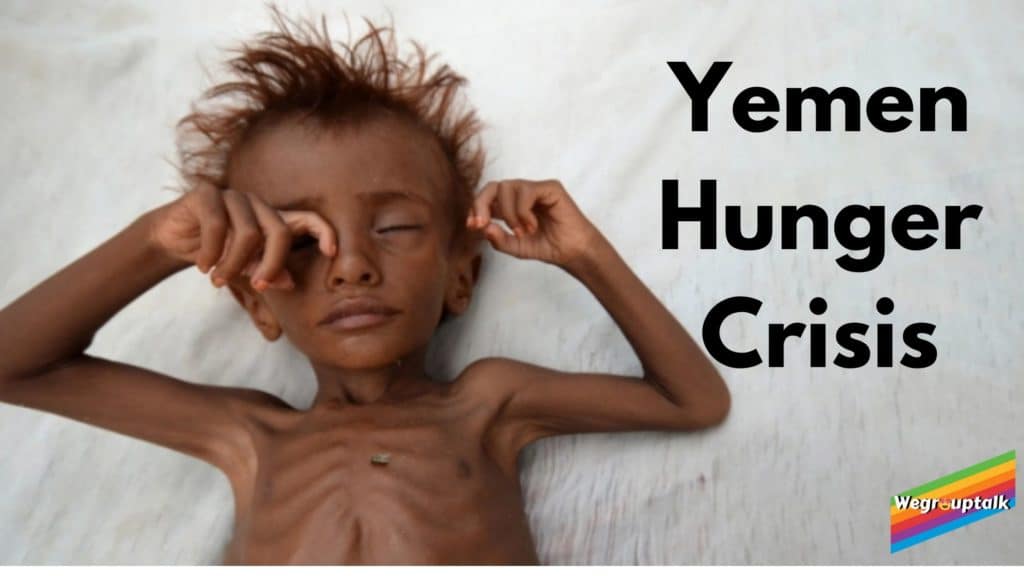
4. ZAMBIA
There is no specific root cause of hunger – they are complex and seems like the different direction of the map. In Zambia, 70% of the population is poor, and 58% are classified as extremely poor. Hunger and food insecurity have reached unmatched levels. Hunger is intimately intertwined with poverty. As a consequence of hunger and food and nutrition insecurity, 48% of Zambia’s under-five children are stunted, 25% are underweight, 6% are severely malnourished.
I hope this article managed to give you an insight into what type of strategy should be followed to eradicate the world hunger and which all are the severely hunger-stricken countries. In the end, I would like to plead you all to do your part of not wasting food, whenever and wherever possible donating food to the ones in need and making this world a better place to live in. Let us all come together and spread smiles on the faces that seem to be malnourished; after all, they are humans like us.
Follow us on Facebook, Instagram and Twitter to stay connected!!!!
Also Read- Why is Hunger Still a Problem?

